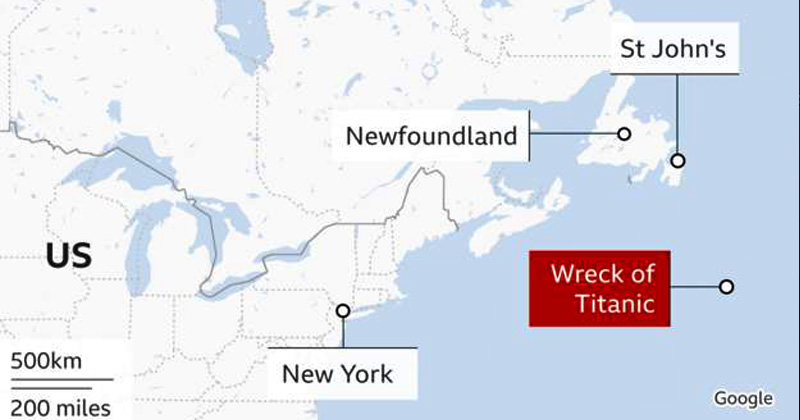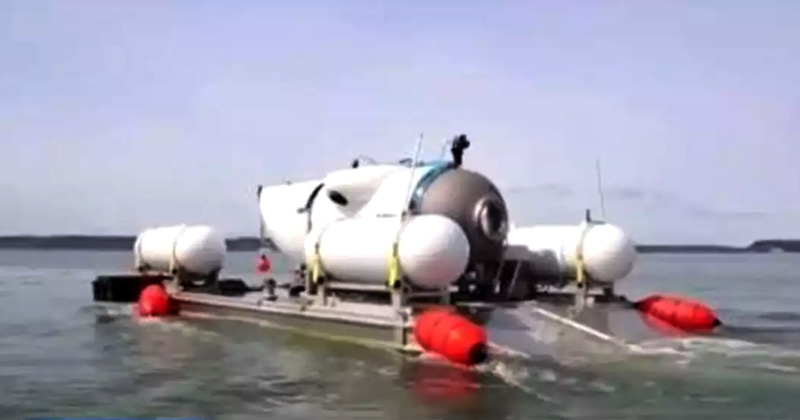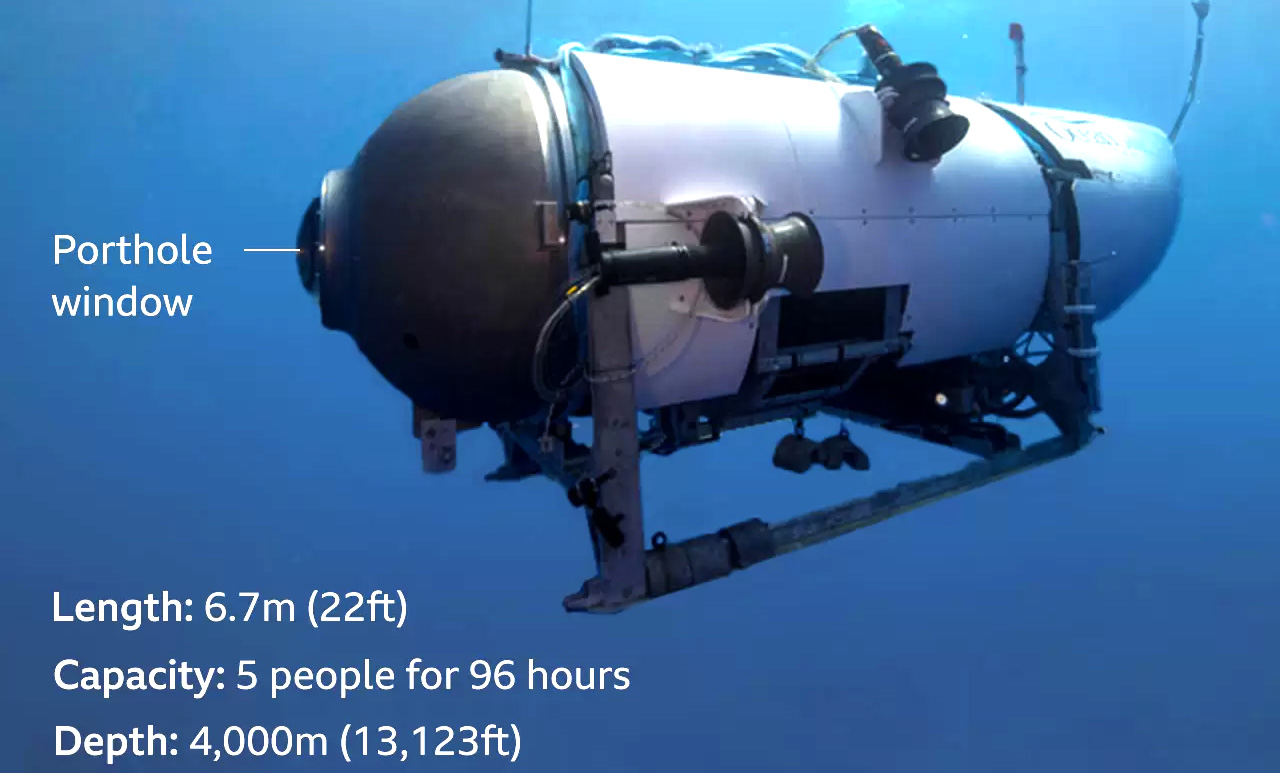An extensive search and rescue mission has been launched in the North Atlantic following the disappearance of a submersible engaged in exploring the wreckage of the Titanic. The research vessel, Polar Prince, lost communication with the crew of the Titan sub approximately one hour and 45 minutes after the dive began. At 17:00 EST (22:00 BST) on Monday, the US Coast Guard provided an estimate that the submersible possessed an emergency oxygen supply lasting between 70 and 96 hours.
OceanGate, the tour firm responsible for the expedition, has committed to exploring every available avenue to ensure the safe return of the crew. Government agencies have swiftly joined forces in this rescue operation, pooling their resources and expertise in the race against time.
The Titanic Wreckage Revealed

On Sunday morning, the research vessel Polar Prince reached the vicinity of the Titanic wreck in the Atlantic Ocean. Hamish Harding, aboard the Titan submersible, shared in a Facebook post that they anticipated commencing their dive in the submersible at 04:00 local time.
Leading the search operation, the Boston Coast Guard took to Twitter to report that the five-person crew "submerged Sunday morning, and the crew of the Polar Prince lost contact with them approximately one hour and 45 minutes into the vessel's dive." At that time, the Titan submersible was estimated to be roughly 900 miles (1450km) off the coast of Cape Cod.
Rear Admiral John Mauger of the US Coast Guard acknowledged the considerable challenge posed by conducting a search in such a remote area. He outlined the two primary aspects of the search operation, which involve a surface search in case the Titan submersible has resurfaced but encountered communication issues, as well as an underwater sonar search.
The Coast Guard has dispatched two C-130 Hercules aircraft, accompanied by a Canadian C-130 and a P8 aircraft equipped with underwater sonar capability, to conduct a search for the missing submersible on the water's surface. To enhance the search efforts, sonar buoys are being deployed in the designated area.
Rear Admiral John Mauger of the US Coast Guard expressed the necessity for additional expertise in the event that the submersible is located underwater. He has sought assistance from various sources, including the US Navy and the private sector.
Canada's defense department confirmed that, in addition to the aircraft, the Canadian coast guard vessel Kopit Hopson is aiding in the search operation.
The Missing Individuals
Among the individuals aboard the Titan submersible, three have been officially confirmed thus far. These include Hamish Harding, a 58-year-old British businessman and explorer, as well as Shahzada Dawood, a Pakistani businessman, and his son Suleman Dawood.
Hamish Harding, who announced his participation in the expedition in June of the previous year, mentioned that the crew includes "a couple of legendary explorers, some of which have done over 30 dives to the RMS Titanic since the 1980s." Harding serves as the chairman of Action Aviation, an international company based in Dubai, United Arab Emirates, specializing in sales and operations within the business aviation industry.
On Sunday, Harding's firm provided an update on Twitter stating that the submersible had launched successfully, and Hamish was currently diving.

In a statement released on Tuesday, the Dawood family acknowledged that their son Shahzada Dawood and his son Suleman had embarked on a journey to visit the remains of the Titanic in the Atlantic Ocean. Contact with their submersible craft has been lost, with limited information available. They expressed gratitude for the concern expressed by colleagues and friends and requested privacy while asking for prayers for their safety.
According to a Facebook post by Hamish Harding before the dive, French explorer Paul-Henry Nargeolet is also believed to be on board.
Additionally, Stockton Rush, the chief executive of OceanGate, the company leading the dive, is widely reported to be among the individuals on the vessel.
Location and Fate Uncertain
OceanGate Expeditions offers exclusive eight-day expeditions to explore the renowned Titanic wreck, situated 3,800m (12,500ft) below the surface in the Atlantic. The wreck is located approximately 600km (370 miles) off the coast of Newfoundland and is divided into two sections, with the bow and stern separated by about 800m (2,600ft), surrounded by a vast debris field.
The complete dive, including descent and ascent, reportedly takes eight hours. Each expedition, lasting eight days, includes scientific objectives such as studying the decay of the wreck. The inaugural dive occurred in 2021, according to OceanGate's website.
Submarine expert Prof Alistair Greig from University College London has considered various possibilities regarding the missing submersible's whereabouts. One scenario suggests that the submersible may have released a "drop weight" after encountering an emergency, allowing it to float on the surface awaiting rescue in case of power or communication failure.
Another, less favorable scenario involves a compromised hull and potential leak, which could greatly impact the submersible's prognosis. If the submersible has descended to the seabed and cannot resurface independently, the options, as explained by Prof Greig, become extremely limited.
Given depths exceeding 200m (656ft), only a handful of vessels possess the capability to reach such depths, with divers unable to access those depths. Vehicles designed for navy submarine rescue are also unsuitable for reaching the depths of the Titanic wreck.
About Titan
The Titan, a submersible designed to accommodate five individuals, is engineered to descend to depths of 4,000 meters (2.5 miles) and can travel at a speed of three knots, equivalent to approximately 3.5 miles per hour.
 Aside from its primary purpose of transporting divers to the iconic Titanic wreck, the Titan serves a range of functions including site surveys, inspections, research and data collection, film and media production, as well as testing hardware and software in deep-sea environments. According to OceanGate, the Titan is equipped with advanced lighting, sonar navigation systems, and both internal and external 4K video and photographic equipment.
Aside from its primary purpose of transporting divers to the iconic Titanic wreck, the Titan serves a range of functions including site surveys, inspections, research and data collection, film and media production, as well as testing hardware and software in deep-sea environments. According to OceanGate, the Titan is equipped with advanced lighting, sonar navigation systems, and both internal and external 4K video and photographic equipment.
OceanGate's website states that the five-person submersible is equipped with a real-time hull monitoring system. This system utilizes sensors to analyze the impact of changing pressure on the submersible during dives, ensuring the structural integrity of the vessel.
The company emphasizes that this onboard health analysis monitoring system provides the pilot with early warning detection, allowing for timely intervention to halt the descent and safely return to the surface. Journalist David Pogue, who had the opportunity to board the Titan, noted that he encountered a waiver describing the submersible as an "experimental" vessel, indicating that it had not received approval or certification from any regulatory body. The waiver further highlighted potential risks, including physical injury, disability, emotional trauma, or death.
During his tour of the submersible, OceanGate CEO Stockton Rush revealed that the vessel's controls consist of a single button and are operated using a video game controller, providing a unique and intuitive interface for the pilot.